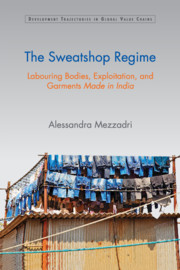Book contents
- Frontmatter
- Dedication
- Contents
- List of Tables, Figures and Pictures
- Acknowledgements
- List of Abbreviations
- Introduction
- 1 The Chain and the Sweatshop
- 2 The Commodity and the Sweatshop
- 3 Difference and the Sweatshop
- 4 The Regional Lord and the Sweatshop
- 5 The Broker and the Sweatshop
- 6 The Body and the Sweatshop
- Conclusions
- References
- Index
1 - The Chain and the Sweatshop
Published online by Cambridge University Press: 23 July 2017
- Frontmatter
- Dedication
- Contents
- List of Tables, Figures and Pictures
- Acknowledgements
- List of Abbreviations
- Introduction
- 1 The Chain and the Sweatshop
- 2 The Commodity and the Sweatshop
- 3 Difference and the Sweatshop
- 4 The Regional Lord and the Sweatshop
- 5 The Broker and the Sweatshop
- 6 The Body and the Sweatshop
- Conclusions
- References
- Index
Summary
… the apparel industry, as presently constituted, is exploitative at its core.
(Bonacich and Appelbaum, 2000, p. 22)Global Products, Sweatshop Labour: Introducing the ‘Made in India’
We wear and consume globalization on a daily basis. The majority of the products we purchase are global products, created through a complex organization of production stretching across the world economy. Garments are the global product par excellence. If we read the labels of the clothes we wear, we immediately realize that, at present, they come from a staggering number of different countries. Today, even the least remarkable among local clothing shops, malls and boutiques in many developed as well as emerging economies is likely to sell ‘global’ garments: jeans made in Bangladesh, T-shirts made in India, trousers made in China, Cambodia or Vietnam, coats made in Italy, Turkey or Mexico. Being produced in so many different parts of the world, these garments share a number of common traits. First, they are often extremely cheap. In the last four decades, the price of readymade clothing has fallen massively. In Europe and the US, retail stores such as Primark or Wal-Mart sell garments for the price of an ice cream or a slice of pizza. Second, garments come in myriads of different styles that change more rapidly that even fickle consumer taste could ever do. In fact, it is this continuous process of change – the ‘fast fashion’ model – that is increasingly leading to shifts in consumer taste among middle classes worldwide. Third, while vaguely indicating the country of production, garments hardly provide any other clue regarding their exact origins. This labelling politics contributes to the representation of production regions as undifferentiated lands, effectively hiding the exact location of production, and with it the source of value.
Eventually, we do learn where exactly given garments come from. Sadly, however, this process of discovery is generally linked to the unfolding of terrible industrial disasters or the unveiling of sweatshop scandals. Until April 2013, consumers had perhaps never heard of an industrial area called Savar, in Dhaka, Bangladesh. Now, many do, after the collapse of Rana Plaza, an eight-storey building hosting garment factories producing for global buyers.
- Type
- Chapter
- Information
- The Sweatshop RegimeLabouring Bodies, Exploitation and Garments <I>Made in India</I>, pp. 16 - 41Publisher: Cambridge University PressPrint publication year: 2016

